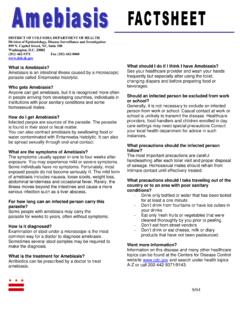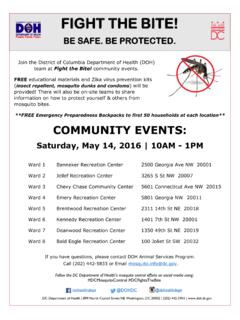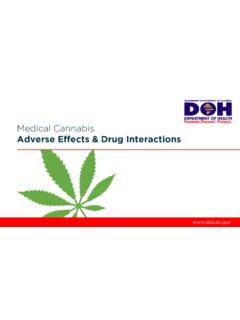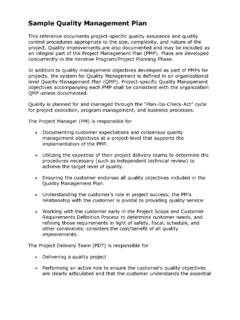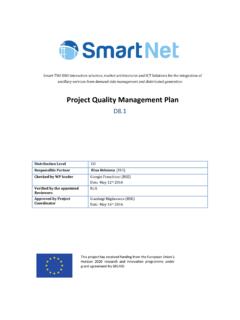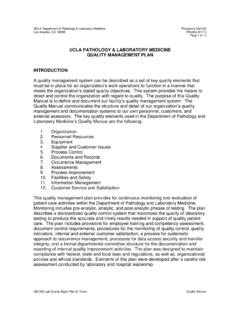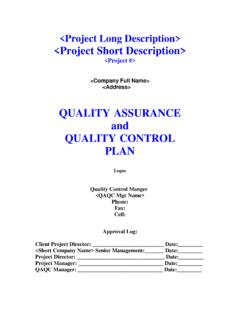Transcription of DC CROSS-PART COLLABORATIVE 2013 HIV QUALITY …
1 DC CROSS-PART COLLABORATIVE 2013 HIV QUALITY management plan PREPARED BY: DC CROSS-PART RESPONSE TEAM i ii Table of Contents SECTION: A QUALITY STATEMENT ..4 Vision ..4 Purpose ..4 SECTION: B DEFINITION OF QUALITY ..5 Indicator ..5 Performance Measure ..5 plan -Do-Study-Act (PDSA) Cycles ..5 QUALITY Assurance (QA) ..6 QUALITY Improvement (QI) ..6 QUALITY management (QM)..6 Outcomes ..6 Outcome Indicator ..6 SECTION: C QUALITY management INFRASTRUCTURE ..6 Programmatic Leadership ..6 DC CROSS-PART COLLABORATIVE Response Team ..7 Internal SECTION: D GOALS AND IMPLEMENTATION plan ..10 QUALITY management Program Work plan 2013 -2014.
2 11 SECTION: E CAPACITY BUILDING ..12 SECTION: F PERFORMANCE MEASUREMENT ..12 SECTION: G PARTICIPATION OF STAKEHOLDERS ..14 SECTION: H iii QUALITY management PROGRAM EVALUATION ..14 SECTION: I PROCESS TO UPDATE THE HIV QUALITY management plan ..15 SECTION: J COMMUNICATION plan ..15 SECTION: K LIMITATIONS ..16 ACRONYMS ..17 ACKNOWLEDGEMENTS ..19 LIST OF APPENDICES APPENDIX A: RESPONSE TEAM MEMBERSHIP ..21 APPENDIX B: COLLABORATIVE MEMBERSHIP ..24 APPENDIX C: THREE-YEAR STRATEGIC plan ..26 APPENDIX D: IMPLEMENTATION/WORK plan FY2011-2012 ..29 APPENDIX E: CAPACITY BUILDING ..34 APPENDIX F: PERFORMANCE MEASURES.
3 35 iv 1 INTRODUCTION The Health, Resources and Services Administration (HRSA) of the HIV/AIDS Bureau (HAB) sponsored the development of the DC Eligible Metropolitan Area (DC EMA) QUALITY management (QM) CROSS-PART COLLABORATIVE (the COLLABORATIVE ) in January 2011 to strengthen the regional capacity for collaboration across Ryan White (RW) HIV/AIDS Program Parts (Parts A, B, C, D and F). Under the leadership of the National QUALITY Center (NQC) the COLLABORATIVE worked for alignment of QM goals to jointly meet the RW HIV/AIDS Program legislative mandates, and to implement QUALITY improvement (QI) activities to jointly advance the QUALITY of care for people living with HIV/AIDS (PLWHA) across jurisdictions within the Area DC EMA and to coordinate HIV services seamlessly across Parts.
4 Since May 2012, HAB and NQC have endorsed the work of the COLLABORATIVE to continue under guidance of the Response Team, HAHSTA, and the participating administrative agents. The various Parts were created by HRSA, each with a specific grant structure and reporting requirements in response to the Ryan White HIV/AIDS Treatment Modernization Act of 2009. Grantees, administrative agents, HIV care providers, and consumers representing each of the Parts and other stakeholders from the DC EMA came together to form the COLLABORATIVE . A complete listing of the COLLABORATIVE membership and their affiliation with the RW Program Parts can be found in Appendix A.
5 The Parts and their grantees within the DC EMA are listed below. part A: Grants to Eligible Metropolitan Areas and Transitional Grant Areas part A provides emergency assistance to Eligible Metropolitan Areas (EMAs) and Transitional Grant Areas (TGAs) that are most severely affected by the HIV/AIDS epidemic. part A funds are used for PLWHA who are uninsured, underinsured or underserved to ensure access to core medical and support health services that enhance access to care; maintain clients in care, particularly primary care services; and ensure continuity of care. The DC EMA, the District s Department of Health (DOH) HIV/AIDS, Hepatitis, STD and TB Administration s (HAHSTA) Care Bureau is the designated DC EMA grantee.
6 HAHSTA provides oversight to DC and West Virginia (WV) providers directly. In Suburban Maryland (MD) and North Virginia (NOVA), HAHSTA contracts with the Suburban Maryland and Administrative Agency (SMAA) within the Prince George s County Health Department and the Northern Virginia Regional Commission (NVRC) respectively to provide oversight to providers serving their jurisdictions. Providers offering Outpatient/Ambulatory Medical Care (Medical Care) and Medical Case management (MCM) services throughout the DC EMA were invited to attend the COLLABORATIVE . DC, West VA, Suburban MD and Northern VA are currently represented. part B: Grants to States and Territories part B provides grants including a base grant to supplement core medical and support services, the AIDS Drug Assistance Program (ADAP) award, ADAP supplemental grants and grants to States for Emerging Communities (EC).
7 The DOHs within each of the four jurisdictions of the DC EMA are the grantees for their State/District s part B funds which include the counties, cities and the District within the DC EMA. Each DOH receives a base grant, ADAP and ADAP supplemental grants. In Maryland, their ADAP is known as MADAP. West Virginia also receives EC grant. The grantees can choose to provide services 2 directly through their local health departments or a consortium. All four State/Territory Health Departments are participating in the COLLABORATIVE along with some of their Medical Care Providers. In addition, Minority AIDS Initiative (MAI) grants are provided to address HIV/AIDS care needs under Parts A, B, C and D to address the HIV/AIDS care needs of African Americans and other disproportionately impacted communities.
8 In the DC EMA, MAI funds are provided to the grantees under Parts A and B to DC, MD and VA. part C: Early Intervention Services part C provides grants directly to service providers such as ambulatory medical clinics to support outpatient Early Intervention Services (EIS) and ambulatory care for services at their facility location. The part C grantees participating in the COLLABORATIVE represent federally qualified health centers (FQHCs), community-based organizations (CBOs), other medical clinics and a research institute. part D: Services for Women, Infants, Children, Youth and Families part D provides grants for family-centered primary medical care involving outpatient or ambulatory care (directly, through contracts or through memoranda of understanding) for women, infants, children, and youth with HIV/AIDS.
9 part D funds primary medical care, treatment and support services to improve access to health care. Two (2) part D grantees, Children s National Medical Center (CNMC) located in DC and Inova Juniper Program in NVa are participating in the COLLABORATIVE . part F: AIDS Education and Training Centers Program and Dental Reimbursement Program & Special Programs of National Significance (SPNS) part F provides grants to support the AIDS Education and Training Centers (AETC) Program and the Dental Reimbursement Program (DRP). The AETC conducts targeted, multidisciplinary education and training programs for health care providers treating PLWHA.
10 The Pennsylvania/Mid-Atlantic (PA/MA) AETC serves Delaware, DC, MD, Ohio, Pennsylvania, VA, and WV. Currently, the VA and DC Local Performance Sites (LPS) of the PA/MA AETC are participating in the COLLABORATIVE . The MD site has been invited, but has not joined. The DRP unds institutions that have dental or dental hygiene education programs improve ftoaccess to oral health care services for PLWHA. The DRP simultaneously educates dental hygiene students and residents about comprehensive care specific to HIV/AIDS. Only Howard University s Dental Program in the District receives DRP funds to serve the DC EMA. SPNS Programs support the development of innovative models of HIV care to quickly respond to the emerging needs of clients served by the Ryan White HIV/AIDS Programs.


